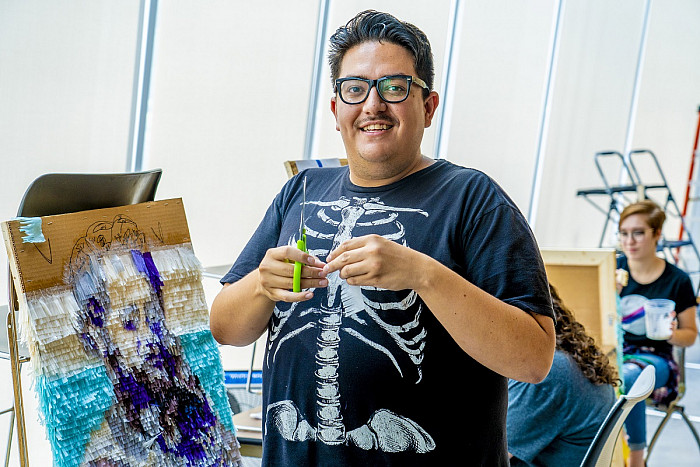

Open gallery

Piñata Installation Adorns Berman’s Pfeiffer Wing
Favela is an artist and podcast host who has made a name for himself all across the country for his distinct piñata art style.
“I kind of stayed away from making art about myself for a long time but finally for my thesis show for my undergrad I decided I wanted to do a piece about my identity. My mom is Guatemalan and my dad is Mexican. I’m from Las Vegas, first generation, and I wanted a symbol that represents my identity.I immediately thought about the piñata,” Favela says.
In the Berman Museum of Art, Favela has spent several weeks working on a large piñata piece with the help of student, faculty, staff, and community volunteers. The installation spans multiple walls and even ventures onto the ceiling of the space in the Pfeiffer Wing. The piece is made using what Favela refers to as “accessible” materials which are familiar to most people: brightly colored tissue paper, cardboard, glue and a keen eye for design.
When you walk through the exhibition up close and see all of the colorful paper, it can be difficult at first to see the big picture, literally and figuratively.
“Something that I really enjoy is people looking at it objectively and seeing the pretty colors and handmade work, just spending time in the space and enjoying your day, but if you look through the layers there’s always a message with my work,” Favela shares. “It’s up to the viewer, really. I find art like that more interesting.”
Taking a few steps back can help the viewer see the wider image, a recreation of Mexican landscape artist José María Velasco’s 19th century painting, Valley of Oaxaca.
“These paintings were really the symbols of the nation,” explains Favela about Velasco’s work. “They traveled the world to show people how beautiful Mexico was. When you look at this, there’s a lot of symbolism in here. It’s a very beautiful, picturesque version of this. I’ve been to Mexico; I’ve been to these areas and it doesn’t look anything like this and it wouldn’t have look like that when you went there back then. These are very romanticized, fluffy versions of Mexico.”
“I started making these paintings in a piñata style. The further away you are from the image the clearer it is, which speaks to the nature of these paintings. If you’ve never been to Mexico before you think that this is reality, but if you actually stand in these spaces it doesn’t look anything like what it’s representing.”
Favela likes to take up space with his work, the bigger the better. He has even covered an entire building—a motel in Las Vegas—in various shades of pink tissue paper.
The idea of taking up space in the world is something that he links to race and privilege and how we’re brought up.
“I can tell a lot about a person by the way that they’re standing in a room and how they’re taking up space in a room. And so that idea comes through with my art too,” he says. “What’s the biggest way to make an impact in the art world? Make something really big and it’s like you’re confronted by it or you’re in it. You can walk into the space and feel welcomed by this or you can be confronted by this. Depending on your reaction to it, it says a lot about you and what you’ve experienced which I think is important. I think sometimes art should confront people with stuff.”
Favela’s large installation, The Valley of Oaxaca, as well as a collection of smaller works entitled Re/Presenting México José María Velasco and the Politics of Paper, are presented alongside Matthias Schaller’s Das Meisterstück exhibition opening on Sept. 6, 2018, and running through December. —Mary Lobo ’15